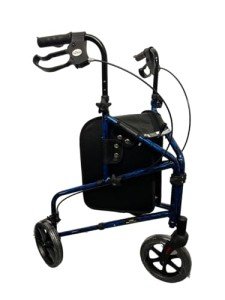walking-aids7040
walking-aids7040
16 Must-Follow Facebook Pages For Rollator Walker-Related Businesses
Rollator Walker Safety: A Comprehensive Guide
As people age or face mobility challenges due to health problem or injury, preserving self-reliance often becomes a priority. Rollator walkers, providing both support and mobility, have actually become invaluable tools for lots of. Nevertheless, while they offer numerous benefits, guaranteeing safety while utilizing a rollator walker is vital. This short article provides thorough insights into rollator walker safety, consisting of best practices, common threats, and important ideas for users and caretakers.

Understanding Rollators
A rollator walker is a mobility gadget with wheels that permits people to stroll with the assistance of a frame. Unlike basic walkers, rollators generally include:
- Three or 4 wheels for simpler maneuverability
- Hand brakes for stopping and managing speed
- A seat for resting when needed
- Storage compartments for carrying personal products
These functions make rollators suitable for both indoor and outdoor use, boosting the lifestyle for users by offering a sense of independence.
Benefits of Using Rollator Walkers
- Increased Mobility: Rollators can help users in moving around securely and comfortably.
- Support and Stability: With a sturdy frame and brakes, they supply essential support when standing or walking.
- Comfort: Many rollators come with padded seats, allowing users to rest as needed.
- Convenience: Integrated storage services can bring necessary items, freeing hands for much better balance.
Common Hazards Associated with Rollator Walkers
While rollators can enhance mobility and safety, they can likewise present risks. Users must know possible threats to minimize accidents:
- Uneven Surfaces: Rollators may tip over if used on uneven or sloped surface.
- Braking Issues: Failing to engage the brakes effectively can lead to falls.
- Excess Weight: Overloading the storage compartments can impact stability.
- Inappropriate Use: Not utilizing the rollator as planned can lead to mishaps.
- Poor Maintenance: Neglecting regular look at wheels and brakes might result in failure throughout use.
Rollator Walker Safety Tips
To improve safety while using rollator walkers, think about the following pointers:
1. Appropriate Fit and Adjustment
- Height Adjustment: Ensure that the handle height is set to the user’s wrist level when standing upright. An appropriate fit motivates much better posture and control.
- Seat Height: If the rollator has a seat, guarantee it’s comfy and accessible for resting.
2. Routine Maintenance
- Check Brakes: Make sure hand brakes are functioning appropriately. Change or replace them if needed.
- Examine Wheels: Regularly inspect wheels for wear and tear, and guarantee they spin easily.
- Analyze Frame: Check for loose screws or cracks in the frame to ensure it stays sturdy.
| Upkeep Task | Frequency |
|---|---|
| Brake inspect | Weekly |
| Wheel inspection | Monthly |
| Frame assessment | Monthly |
3. Environment Awareness
- Clear Pathways: Keep living areas devoid of clutter and challenges that might position a tripping danger.
- Lighting: Ensure that locations are well-lit to avoid errors, particularly during evening hours.
- Avoid Slippery Floors: Be mindful on damp or waxed floorings, as they can cause falls.
4. Safe Walking Techniques
- Engage Brakes When Stopping: Always engage brakes before sitting or while resting.
- Use Proper Walking Technique: Move slowly and keep a stable speed, taking steps that match the rollator’s width.
- Balance While Turning: Turn carefully, using the rollator for assistance as required.
5. Look for Assistance
- Include Caregivers: Encourage member of the family or caretakers to assist in navigating tough terrains or situations.
- Make The Most Of Community Resources: Many neighborhoods use mobility training for those using walk-assisting gadgets.
FAQs about Rollator Walker Safety
Q1: How do I choose the best rollator walker?
When selecting a rollator, think about the user’s weight, height, and planned use. It’s also important to examine for functions such as hand brake efficiency and wheel size, which can impact maneuverability.
Q2: Can I use a rollator walker on unequal surface areas?
While rollators can handle a variety of surfaces, it is best to prevent high slopes, gravel, or cobblestones, as these can be harmful. Stick to flat, smooth surface areas whenever possible.
Q3: How can I avoid falls while utilizing a rollator?
Engaging the brakes when sitting, keeping pathways clear, changing your rollator for the right height, and bearing in mind your surroundings can considerably minimize the threat of falls.
Q4: Are all rollator walkers the same?
No, rollators come in different types and sizes, developed for various requirements. Some might have extra accessories like baskets, while others are lightweight or function a higher weight capacity.
Q5: Is it safe to bring bags on a rollator?
Always be conscious of the weight limitation and circulation of the load. Use the rollator’s designated storage solutions and avoid straining it.
Rollator walkers are invaluable gadgets that enhance mobility and promote independence for users dealing with mobility challenges. Nevertheless, making sure safety while utilizing these devices is vital. By understanding possible threats, sticking to safe practices, and preserving the walker routinely, users can take pleasure in the benefits of their rollator with minimized threat. Ultimately, the objective is to assist in confidence and stability, allowing individuals to browse their world with security and ease. As care service providers, relative, and communities focus on safety, they empower users towards a better, more independent lifestyle.




